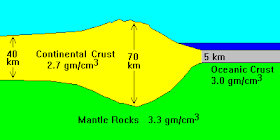Virginia Technical University geologists have published research today indicating some of that continental crust may actually be new or "juvenile" crust.
Some of the type areas for this discovery are in Costa Rica and Panama:
The March 31, 2015, research includes this description of continental and oceanic crust:
"The researchers used geochemical and geophysical data to reconstruct the evolution what is now Costa Rica and Panama, which was generated when two oceanic plates collided and melted iron- and magnesium-rich oceanic crust over the past 70 million years."
"Melting of the oceanic crust originally produced what today are the Galapagos islands, reproducing Achaean-like conditions to provide the "missing ingredient" in the generation of continental crust."
"The researchers discovered the geochemical signature of erupted lavas reached continental crust-like composition about 10 million years ago. They tested the material and observed seismic waves traveling through the crust at velocities closer to the ones observed in continental crust worldwide."
The study continues "It raises questions about the global impact newly generated continental crust has had over the ages, and the role it has played in the evolution of not just continents, but life itself.
For example, the formation of the Central American land bridge resulted in the closure of the seaway, which changed how the ocean circulated, separated marine species, and had a powerful impact on the climate on the planet."
Older names for continental and oceanic crust are SIAL and SIMA, respectively. Sial is a short for silica aluminum (or aluminum silicate) and sima is short for silica magnesium (or magnesium silicate). The sial is less dense than the sima. And now, researchers have shown that some of that sial is juvenile.
SIAL LATER!
Steph
Some of the type areas for this discovery are in Costa Rica and Panama:
The March 31, 2015, research includes this description of continental and oceanic crust:
"The researchers used geochemical and geophysical data to reconstruct the evolution what is now Costa Rica and Panama, which was generated when two oceanic plates collided and melted iron- and magnesium-rich oceanic crust over the past 70 million years."
"Melting of the oceanic crust originally produced what today are the Galapagos islands, reproducing Achaean-like conditions to provide the "missing ingredient" in the generation of continental crust."
"The researchers discovered the geochemical signature of erupted lavas reached continental crust-like composition about 10 million years ago. They tested the material and observed seismic waves traveling through the crust at velocities closer to the ones observed in continental crust worldwide."
The study continues "It raises questions about the global impact newly generated continental crust has had over the ages, and the role it has played in the evolution of not just continents, but life itself.
For example, the formation of the Central American land bridge resulted in the closure of the seaway, which changed how the ocean circulated, separated marine species, and had a powerful impact on the climate on the planet."
Older names for continental and oceanic crust are SIAL and SIMA, respectively. Sial is a short for silica aluminum (or aluminum silicate) and sima is short for silica magnesium (or magnesium silicate). The sial is less dense than the sima. And now, researchers have shown that some of that sial is juvenile.
SIAL LATER!
Steph















.jpg)
.jpg)







